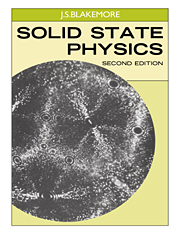Book contents
- Frontmatter
- Contents
- Preface
- General references
- Chapter One CRYSTALLINITY AND THE FORM OF SOLIDS
- Chapter Two LATTICE DYNAMICS
- Chapter Three ELECTRONS IN METALS
- Chapter Four SEMICONDUCTORS
- Chapter Five DIELECTRIC AND MAGNETIC PROPERTIES OF SOLIDS
- TABLE OF SOME USEFUL NUMERICAL CONSTANTS
- AUTHOR INDEX
- SUBJECT INDEX
Preface
Published online by Cambridge University Press: 05 June 2012
- Frontmatter
- Contents
- Preface
- General references
- Chapter One CRYSTALLINITY AND THE FORM OF SOLIDS
- Chapter Two LATTICE DYNAMICS
- Chapter Three ELECTRONS IN METALS
- Chapter Four SEMICONDUCTORS
- Chapter Five DIELECTRIC AND MAGNETIC PROPERTIES OF SOLIDS
- TABLE OF SOME USEFUL NUMERICAL CONSTANTS
- AUTHOR INDEX
- SUBJECT INDEX
Summary
This book was written as the text for a one quarter, or one semester, introductory course on the physics of solids. For an undergraduate majoring in physics, the associated course will usually be taken during the last two undergraduate years. However, the book is designed also to meet needs of those with other degree majors: in chemistry, electrical engineering, materials science, etc., who may not encounter this requirement in their education until graduate school. Some topics discussed (band theory, for example) require familiarity with the language and concepts of quantum physics; and an assumed level of preparedness is one semester of “modern physics”. A reader who has taken a formal quantum mechanics course will be well prepared, but it is recognized that this is often not possible. Thus Schrödinger's equation is seen from time to time, but formal quantum mechanical proofs are side-stepped.
The aim is thus a reasonably rigorous – but not obscure – first exposition of solid state physics. The emphasis is on crystalline solids, proceeding from lattice symmetries to the ideas of reciprocal space and Brillouin zones. These ideas are then developed: for lattice vibrations, the theory of metals, and crystalline semiconductors, in Chapters 2, 3, and 4 respectively. Aspects of the consequences of atomic periodicity comprise some 75% of the book's 500 pages.
- Type
- Chapter
- Information
- Solid State Physics , pp. vii - viiiPublisher: Cambridge University PressPrint publication year: 1985

